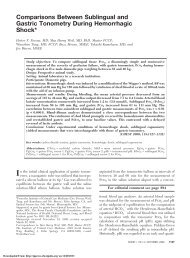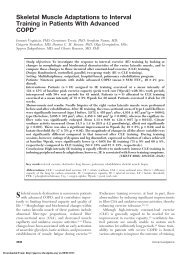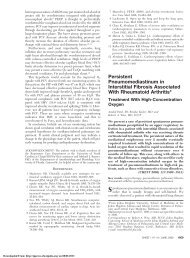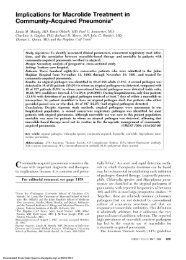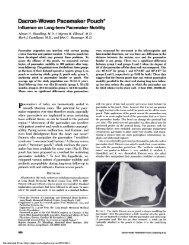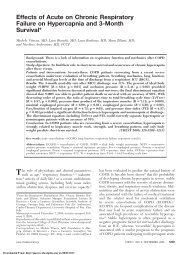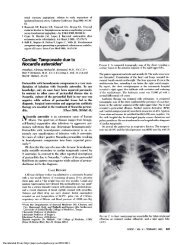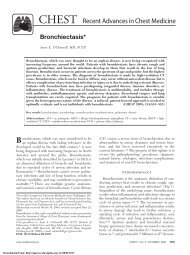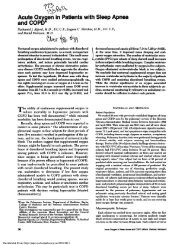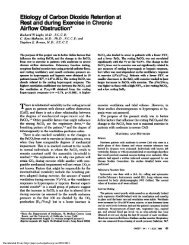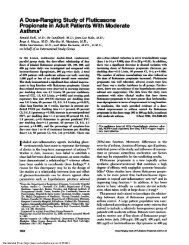Allergic bronchopulmonary aspergillosis - CHEST Publications ...
Allergic bronchopulmonary aspergillosis - CHEST Publications ...
Allergic bronchopulmonary aspergillosis - CHEST Publications ...
Create successful ePaper yourself
Turn your PDF publications into a flip-book with our unique Google optimized e-Paper software.
clinical course and less severe immunologic findings<br />
when compared to ABPA-CB based on the<br />
inference of three studies (total of 124 patients).<br />
12,139,140 In the largest of these three studies<br />
(76 patients), only the A fumigatus-specific IgG<br />
levels were higher in patients with ABPA-CB<br />
compared to ABPA-S. Other immunologic parameters<br />
were not significantly different between the<br />
two groups. 12 In our study of 126 patients, the<br />
clinical, spirometric, and immunologic findings<br />
were not significantly different when classifying<br />
ABPA into ABPA-S and ABPA-CB or as ABPA-S,<br />
ABPA-CB, and ABPA-CB-ORF. 22<br />
However, the course of patients with ABPA-S is<br />
likely to be less severe when compared to those with<br />
ABPA-CB. In a multivariate analysis of 155 patients<br />
with ABPA, we demonstrated that the severity of<br />
bronchiectasis and presence of hyperattenuating<br />
mucoid impaction on HRCT-predicted relapses of<br />
ABPA and the severity of bronchiectasis was an<br />
independent predictor of failure to achieve longterm<br />
remission. 23 Thus it may not be important to<br />
stage the severity of ABPA based on the presence<br />
or absence of CB, but it remains prudent to<br />
diagnose and treat ABPA early to prevent the<br />
development of bronchiectasis because it in-<br />
Table 6—Stages of ABPA 8,22<br />
Stage Description Clinical Picture Radiologic Findings Immunologic Features<br />
I Acute phase Usually symptomatic,<br />
fever, weight loss,<br />
wheeze<br />
Normal or presence of<br />
radiologic opacities<br />
II Remission Asymptomatic Generally normal or significant<br />
resolution of radiologic<br />
opacities from the acute<br />
phase<br />
III Exacerbation Symptomatic as in acute Transient or fixed pulmonary<br />
phase<br />
opacities<br />
IV Glucocorticoid-dependent Symptomatic Transient or fixed pulmonary<br />
ABPA<br />
opacities<br />
V End-stage (fibrotic)<br />
ABPA<br />
Symptomatic, findings of<br />
fixed airway<br />
obstruction, severe<br />
pulmonary<br />
dysfunction, type II<br />
respiratory failure, cor<br />
pulmonale<br />
Evidence of bronchiectasis,<br />
pulmonary fibrosis,<br />
pulmonary hypertension<br />
IgE 1,000 IU/mL, raised<br />
specific IgG/IgE and<br />
precipitins to A fumigatus<br />
Usually 35–50% decline in IgE<br />
levels by 6 wk to 3 mo; we<br />
give additional label of<br />
“complete remission” if the<br />
patient did not have any<br />
additional ABPA exacerbations<br />
over the next 3 mo after<br />
stopping steroid therapy<br />
Doubling of IgE levels from<br />
baseline<br />
Two groups can be identified:<br />
one in whom IgE levels do not<br />
rise but require steroids for<br />
asthma control (glucocorticoiddependent<br />
asthma); the other<br />
in whom steroids are required<br />
to continually suppress the<br />
disease activity (glucocorticoiddependent<br />
ABPA)<br />
Serum IgE levels and specific<br />
immunoglobulins do not<br />
become normal in most<br />
patients, and even these<br />
patients can have frequent<br />
exacerbations<br />
creases the probability of a smoother course of this<br />
relapsing-remitting disorder.<br />
Management<br />
The management of ABPA includes two important<br />
aspects: institution of glucocorticoids to control the<br />
immunologic activity and close monitoring for detection<br />
of relapses. Another possible target is the use of<br />
antifungal agents to attenuate the fungal burden<br />
secondary to the fungal colonization in the airways.<br />
Systemic Glucocorticoid Therapy: Oral corticosteroids<br />
are the treatment of choice for ABPA. They not<br />
only suppress the immune hyperfunction but are also<br />
antiinflammatory. There are no data to guide the<br />
dose and duration of glucocorticoids, and different<br />
regimens of glucocorticoids have been used (Table<br />
8). The use of lower doses of glucocorticoids was<br />
associated with frequent relapses or corticosteroid<br />
dependence (45%). 9 We use a higher dosage of<br />
glucocorticoids for a longer duration and observed<br />
higher remission rates and a lower prevalence of<br />
glucocorticoid-dependent ABPA (13.5%). 22 This<br />
raises the possibility of a higher dose and prolonged<br />
duration of corticosteroid therapy being associated<br />
814 Global Medicine<br />
Downloaded From: http://jupcvss.chestpubs.org/ on 08/01/2013



